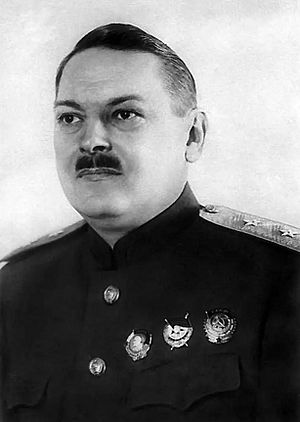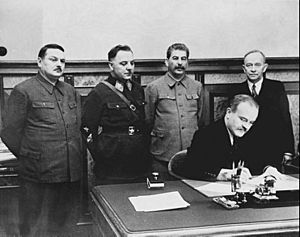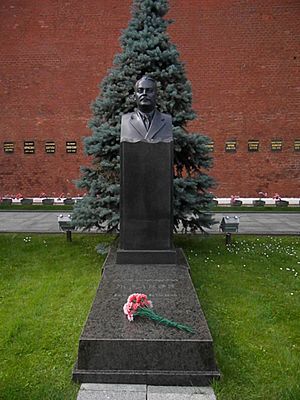Andrei Zhdanov facts for kids
Quick facts for kids
Andrei Zhdanov
|
|||||||||||||||||||||
|---|---|---|---|---|---|---|---|---|---|---|---|---|---|---|---|---|---|---|---|---|---|
|
Андрей Жданов
|
|||||||||||||||||||||

Zhdanov in 1945
|
|||||||||||||||||||||
| Second Secretary of the Communist Party of the Soviet Union | |||||||||||||||||||||
| In office 21 March 1939 – 31 August 1948 |
|||||||||||||||||||||
| Preceded by | Lazar Kaganovich | ||||||||||||||||||||
| Succeeded by | Georgy Malenkov | ||||||||||||||||||||
| Head of the Propaganda and Agitation Department of the Central Committee | |||||||||||||||||||||
| In office 21 March 1939 – 6 September 1940 |
|||||||||||||||||||||
| Preceded by | Post established | ||||||||||||||||||||
| Succeeded by | Georgy Aleksandrov | ||||||||||||||||||||
|
|||||||||||||||||||||
| Personal details | |||||||||||||||||||||
| Born | 26 February 1896 Mariupol, Yekaterinoslav Governorate, Russian Empire |
||||||||||||||||||||
| Died | 31 August 1948 (aged 52) Moscow, RSFSR, Soviet Union |
||||||||||||||||||||
| Resting place | Kremlin Wall Necropolis, Moscow | ||||||||||||||||||||
| Political party | RSDLP(b) (1915–1918) VKP(b) (1918–1948) |
||||||||||||||||||||
| Occupation | Civil servant | ||||||||||||||||||||
|
Central institution membership
1939–1948: Full member, 18th Politburo
1934–1948: Member, 17th & 18th Secretariat 1934-1948: Member, 17th & 18th Orgburo 1934–1939: Candidate member, 17th Politburo 1939–1948: Full member, 17th and 18th Central Committee Other political offices held
1946–1947: Chairman, Soviet of the Union
1944-1947: Director, Allied Control Commission |
|||||||||||||||||||||
Andrei Aleksandrovich Zhdanov (Russian: Андре́й Алекса́ндрович Жда́нов; 26 February 1896 – 31 August 1948) was an important Soviet politician. He was in charge of spreading the Soviet Union's ideas and culture in the 1940s. He helped create a strict cultural policy called the Zhdanov Doctrine. This policy lasted until Joseph Stalin died. Many people thought Zhdanov would become the next leader after Stalin, but he passed away before him.
Zhdanov was born in Mariupol, Ukraine. He joined the Bolsheviks in 1915 and quickly became important in the party. He was a close friend of Stalin. In 1934, he became a secretary of the Central Committee of the Communist Party of the Soviet Union. Later that year, he became the party leader in Leningrad after Sergei Kirov was killed. He played a big part in the Great Purge, a time when many people were arrested or punished.
In 1939, he became a full member of the Politburo of the Communist Party of the Soviet Union. He also became the Second Secretary of the Communist Party and led the Propaganda Department. Zhdanov's power lessened at the start of Second World War. This was because of the difficult Soviet–Finnish War and problems with the Molotov–Ribbentrop Pact. However, he later helped the Soviet Union take over Estonia. He also played a key role in defending Leningrad during its long siege.
After the war, Zhdanov's influence grew again. He helped create a strong foreign policy and set up the Cominform in 1947. He was also in charge of the Soviet Union's cultural rules. His strict campaign, known as the Zhdanov Doctrine, meant that artists had to follow certain rules. If they didn't, they were criticized. Famous artists like Anna Akhmatova and Dmitri Shostakovich were affected. Zhdanov had health problems and lost favor with Stalin because of a disagreement with Yugoslavia's leader, Josip Broz Tito. He died in 1948 from heart failure and was buried in the Kremlin Wall Necropolis.
Contents
Early Life and Rise to Power
Zhdanov was born in Mariupol, which is now in Ukraine. His father was a school inspector. He studied at the Moscow Commercial Institute. In 1914, he joined the Russian army. He became an officer and served in the reserves. He joined the Bolsheviks in 1915.
In 1917, he led the Bolshevik committee in Shadrinsk. During the Russian Civil War, he was a political commissar in the Red Army. In 1923, he became the chairman of the Tver soviet. From 1924 to 1934, he was the first secretary of the Nizhny Novgorod party committee.
Becoming a Party Secretary
Zhdanov got a big promotion in February 1934. He moved to Moscow to become a secretary of the Central Committee of the Communist Party of the Soviet Union. Here, he was in charge of the party's ideas and beliefs. He helped his friend, Aleksandr Shcherbakov, become the secretary of the Union of Soviet Writers. Zhdanov also gave the main speech at the first Soviet Writers' Congress in August 1934. In his speech, he said that writers were like "engineers of human souls."
Zhdanov's next big promotion happened after Sergei Kirov was killed in December 1934. Zhdanov took Kirov's place as the first secretary of the Leningrad (Saint Petersburg) party. He also became a candidate member of the Politburo of the Communist Party of the Soviet Union. In 1935, he and Leonid Zakovsky, who led the secret police in Leningrad, organized the removal of many people from Leningrad. These were people who had been part of the nobility or middle class before the revolution. They also looked for party members who were thought to have supported Leon Trotsky or Grigory Zinoviev.
Zhdanov's Role in the Great Purge
Zhdanov played an important part in the Great Purge. This was a time in the Soviet Union when many people were arrested, put on trial, or punished severely. Zhdanov believed the party should focus on teaching political ideas and preparing new leaders. He approved many lists that led to severe consequences for people.
In August 1936, while on holiday with Stalin, Zhdanov helped remove Genrikh Yagoda, the head of the secret police. Yagoda was accused of stopping Zhdanov from clearing out the Leningrad party. In March 1937, Zhdanov announced that all local party leaders would have to be re-elected. This was a way to remove those who were not fully trusted. Zhdanov was one of the few local party leaders who stayed in his job throughout the Great Purge.
In May 1937, Zhdanov told Leningrad party leaders that Mikhail Chudov and Ivan Kodatsky had been arrested. When an old party member, Dora Lazurkina, tried to speak up for Kodatsky, Zhdanov warned her. She was later arrested and spent 17 years in labor camps.
After the Great Purge
In September 1938, Zhdanov became the head of the Central Committee's Propaganda and Agitation Directorate. This meant he controlled all news, media, and arts for the party. He was also the Chairman of the Supreme Soviet of the Russian Soviet Federative Socialist Republic from 1938 to 1947. From 1938, he was also on the military council for the Soviet Navy.
Zhdanov's rise in power happened as Nikolai Yezhov fell from power. At the 18th Party Congress in March 1939, Zhdanov said that "other means apart from repression" could be used to keep order. He suggested ending the large-scale party purges because "capitalist elements" had been removed. He also said that "hostile elements" had used the purges to harm innocent people.
At the end of the Congress, Zhdanov became a full member of the Politburo. He was one of four secretaries of the Central Committee, along with Stalin, Andrey Andreyevich Andreyev, and Georgy Malenkov. Since Malenkov was not in the Politburo, it seemed Zhdanov was now Stalin's main helper in the party and possibly his successor.
On June 29, 1939, Zhdanov wrote an article in Pravda. He shared his "personal" view that Britain and France were not serious about a military alliance with the Soviet Union. This was the first public hint that the Soviets might sign the Molotov–Ribbentrop Pact a few months later.
Wartime Role

Zhdanov was closely involved in the decision to invade Finland in November 1939. In December, he signed a treaty with the Finnish government that the Soviets had set up. As the Leningrad party leader and someone overseeing the navy, he wanted to increase Soviet power in the Baltic Sea. This would be at the expense of Finland, Estonia, and Latvia. Zhdanov signed the final peace treaty between Finland and the Soviet Union on March 12, 1940.
In June 1940, Zhdanov went to Estonia. His job was to oversee the creation of the Estonian Soviet Socialist Republic and its joining with the Soviet Union. Later, in 1953–1954, a US investigation accused Zhdanov of being involved in the Soviet takeover of the Baltic states.
The difficulties in Finland weakened Zhdanov's political standing. In September 1940, he lost direct control of the Central Committee's Propaganda Department. Georgy Aleksandrov, an ally of Zhdanov's rival Malenkov, took over. Zhdanov's position was further weakened by the German invasion of the Soviet Union. This was because he had been so publicly linked to the failed agreement with Hitler. He was not included in the State Defense Committee (GOKO), which led the war effort. This committee was first controlled by Malenkov and Lavrentiy Beria.
Along with Georgy Zhukov, Zhdanov played a key role during the Siege of Leningrad in the Second World War. In August 1941, he set up a City Defence Council. However, Stalin ordered him to close it. When the siege ended, he was not officially given full credit for saving the city.
After the Moscow Armistice between Finland and the Soviet Union was signed in September 1944, Zhdanov led the Allied Control Commission in Finland. This lasted until the Paris Peace Treaty in 1947. This meant he had to spend several months in Helsinki. He gave up his job as head of the Leningrad party, which he had held for nine years. However, he was able to leave it to his ally, Alexey Kuznetsov. In January 1945, when the newspaper Pravda celebrated the end of the Siege of Leningrad, it mentioned that Malenkov and Vyacheslav Molotov had been sent to the city in 1941. This suggested they shared the credit with Zhdanov.
Post-War Influence
Zhdanov made a political comeback in 1946. His main rival, Malenkov, temporarily lost his position as a party secretary. For the next two years, Stalin gave Zhdanov the job of guiding the Soviet Union's cultural rules. He also handled relations with the Eastern European countries that were becoming communist. He created what became known as the Zhdanov Doctrine. This doctrine stated that "The only conflict that is possible in Soviet culture is the conflict between good and best." In December 1946, he started to criticize Anna Akhmatova and Mikhail Zoshchenko. These two writers lived in Leningrad, where Zhdanov used to be in charge. Zhdanov was also the first editor-in-chief of the Kultura i zhizn journal until 1948.
In 1947, he helped create the Cominform. This group was meant to help coordinate and control communist parties around the world. In a famous speech in September 1947, Zhdanov told other communists that the world was now divided into two opposing sides. He said the Cominform was needed to fight against the "expansionist program" of the United States.
In January 1948, he led a three-day meeting in the Kremlin. More than 70 composers, musicians, and music critics were called to this meeting. These included famous names like Dmitri Shostakovich, Sergei Prokofiev, Aram Khachaturian, and Nikolai Myaskovsky. Zhdanov lectured them on why they should avoid "formalism" in music. Formalism was a style of art that focused on the structure rather than clear messages. There is a story that Zhdanov played the piano to show how music should be written. However, Shostakovich later strongly denied this story. Zhdanov's cultural policy was about the Soviets "critically taking in the cultural heritage of all nations and all times" to "take what was most inspiring."
Decline and Death

In June 1948, Stalin sent Zhdanov to a Cominform meeting. The goal was to strongly criticize Yugoslavia. However, Zhdanov took a softer approach than his rival, Georgy Malenkov. This made Stalin very angry. Stalin removed Zhdanov from all his positions and replaced him with Malenkov. Zhdanov was soon sent to a special medical facility.
Death
Zhdanov died on August 31, 1948, in Moscow from heart failure. Some people believe his death might have been caused by a wrong medical diagnosis. Zhdanov was buried in the Kremlin Wall Necropolis. This is a special burial place near the Lenin's Mausoleum and the Moscow Kremlin Wall.
Legacy
Even though he was tough on artists like Akhmatova, Shostakovich, and Prokofiev, many experts on the Soviet Union see Zhdanov as a "moderate" leader for his time. The worst events of Stalin's final years happened after Zhdanov died. These included the disagreement with Yugoslavia, the Leningrad affair (a harsh removal of Zhdanov's former allies), and the anti-Jewish Doctors' plot. The Leningrad Affair was a brutal purge of Zhdanov's former allies, like Kuznetsov and Nikolai Voznesensky. One important person who survived this purge was future Prime Minister Alexei Kosygin.
Stalin had talked about Zhdanov being his successor. However, Zhdanov's poor health gave his rivals in the Politburo, like Lavrentiy Beria, Georgy Malenkov, and Nikita Khrushchev, a chance to weaken his position. Stalin later blamed Zhdanov's death on Kremlin doctors and a group he called "Zionist" conspirators.
Zhdanovshchina: Cultural Control
Zhdanovshchina was a strong focus on pure communist ideas that Zhdanov developed during the war. It came from his arguments within the party against a group led by Georgy Malenkov. Malenkov believed in the importance of science and engineering. He wanted to promote technical experts to high positions in the Soviet government. Zhdanov's group, however, said that correct communist ideas were more important than science. They called for focusing on political education and keeping ideas pure.
However, the technical experts had been very successful during the war. They helped with engineering, making goods, and developing advanced weapons. Zhdanov wanted to use the "purification" of party ideas to bring back the Kremlin's control over local areas and the technical experts. He worried that local party leaders and heads of economic departments had become too independent during the war. This was because the top leaders needed to quickly use all human and material resources. After the war, the most important task was rebuilding the country after the massive destruction.
The same reasons that made the technical experts strong continued to exist. The combined opposition of Malenkov, the technical experts, the local party leaders, and key government departments meant Zhdanov's ideas were not fully adopted. So, he turned his attention to making sure art and culture followed strict rules.
Strict Cultural Standards
Starting in 1946 and lasting until the late 1950s, Zhdanov's strict set of ideas, known as the Zhdanov Doctrine or Zhdanovism (zhdanovshchina), set the rules for cultural works in the Soviet Union. Zhdanov wanted to create a new way of thinking about art that would be used everywhere. His method simplified all culture into a system where each symbol matched a simple moral value.
Zhdanov and his team also wanted to remove foreign influences from Soviet art. They said that "incorrect art" was a way of spreading wrong ideas. This doctrine suggested that the world was divided into two opposing sides: the "imperialistic" side, led by the United States, and the "democratic" side, led by the Soviet Union. The main idea of his doctrine was: "The only conflict that is possible in Soviet culture is the conflict between good and best."
This cultural policy was very strictly enforced. It led to censorship of writers, artists, and thinkers. People were punished if they did not follow what Zhdanov considered acceptable. This policy officially ended in 1952. It was seen as having a negative effect on culture in the Soviet Union. The ideas for this policy started before 1946. At that time, some critics wrongly suggested that Russian classic works had been influenced by famous foreign writers. But the policy officially began to target "apolitical, 'bourgeois', individualistic works" by the writer Mikhail Zoshchenko and the poet Anna Akhmatova. They wrote for the literary magazines Zvezda and Leningrad. On February 20, 1948, Zhdanovshchina changed its focus to "anti-formalism." This targeted composers like Dmitri Shostakovich. That April, many of the criticized composers were forced to apologize for showing formalism in their music at a special meeting of the Union of Soviet Composers.
Zhdanov was known as one of the most cultured leaders. His treatment of artists was mild compared to other Soviet leaders at the time. He even wrote a funny sketch making fun of the attacks on modern art.
Family Life
Zhdanov's son, Yuri (1919–2006), married Stalin's daughter, Svetlana Alliluyeva, in 1949. Svetlana described the Zhdanov home as having a strong "spirit of wanting to own many things." She said there were "trunkloads of possessions." She also said that Zhdanov's widow, Zinaida Zhdanova, showed a mix of strong party beliefs and a love for material things. In 1952, Yuri Zhdanov became a member of the Central Committee of the Communist Party of the Soviet Union. He was the head of its Department of Science and Culture. However, he was removed from his job soon after Stalin died. Yuri and Svetlana divorced in 1952. They had one daughter, Yekaterina.
Honours and Awards
- Two Orders of Lenin
- Order of the Red Banner
- Order of Suvorov, 1st class
- Order of Kutuzov, 1st class
- Order of the Red Banner of Labour
- Medal "For the Defence of Leningrad"
- Medal "For the Victory over Germany in the Great Patriotic War 1941–1945"
Zhdanov's hometown, Mariupol, was renamed Zhdanov in his honor in 1948, at Joseph Stalin's request. A monument to Zhdanov was built in the city's main square. The city's name went back to Mariupol in 1989, and the monument was taken down in 1990.
See Also
 In Spanish: Andréi Zhdánov para niños
In Spanish: Andréi Zhdánov para niños
- Engineers of the human soul
- Socialist realism
- Doctors' plot
Images for kids
-
The Soviet leadership signs a treaty with the Finnish Democratic Republic, 1939 (Standing from left to right are Andrei Zhdanov, Kliment Voroshilov, Joseph Stalin and Otto Kuusinen; Vyacheslav Molotov is seated).




